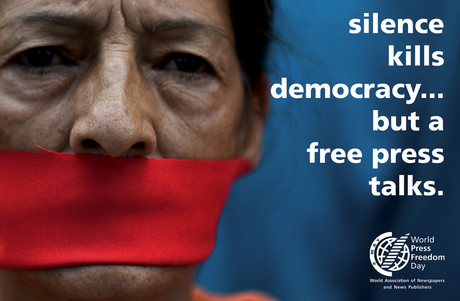 Since its founding in 1948 by survivors of the French and Duch clandestine press of World War II, our organization has believed that a free press is crucial to democracy and that news publishers need to help new generations learn why. The resources, activities and links below are designed to help in that quest.
Since its founding in 1948 by survivors of the French and Duch clandestine press of World War II, our organization has believed that a free press is crucial to democracy and that news publishers need to help new generations learn why. The resources, activities and links below are designed to help in that quest.
ACTIVITIES AND RESOURCES TO CONSIDER
 Our press freedom animation offers a basis for a first discussion about the fragility and importance of press freedom as a key element in freedom of expression. Note: Both this animation and the film mentioned at right should be previewed as they contain some scenes of violence.
Our press freedom animation offers a basis for a first discussion about the fragility and importance of press freedom as a key element in freedom of expression. Note: Both this animation and the film mentioned at right should be previewed as they contain some scenes of violence.
MORE BACKGROUND HERE ABOUT WAN-IFRA PRESS FREEDOM ACTIONS
 Bringing it home: Supporting jailed journalists by buying a bracelet
Bringing it home: Supporting jailed journalists by buying a bracelet
Level of effort - easy
Students at the Unviersity of Maryland's Philip Merrill School of Journalism teamed up with the Committee to Protect Journalists to create a campaign in support of eight journalists in jail. The action is simple: buy a bracelet. The campaign emerged after Washington Post investigative reporter Dana Priest assigned students in her class to profile an imprisoned journalist. Details HERE
 Bringing it home: Supporting the quest to do more to protect journalists
Bringing it home: Supporting the quest to do more to protect journalists
Level of effort: Easy
This campaign focuses on efforts to appoint a Special Representative for Journalists' Safety at the United Nations in New York. WAN-IFRA's campaign is collecting signatures on THIS PETITION. Background about the campaign is HERE.
Bringing it home: Help youth imagine that their parents are sent to jail for what they said, wrote, photographed or drew.
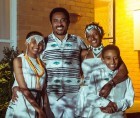 ReunitedLevel of effort - medium. Best if presented in context after consulting our press freedom microsite and the sources at right.
ReunitedLevel of effort - medium. Best if presented in context after consulting our press freedom microsite and the sources at right.
Jiituu Dhabasa Wakjira was only five years old when Ethiopian security forces took away her father, Dhabasa Wakjira, from their home and nine years old when her mother, Lelisse Wodajo, was arrested. The link below is to the text of a speech she gave at age 14 at the Australian Oromo Community Association in Victoria to celebrate the reuniting of the family upon her mother’s release.
http://advocacy4oromia.org/action/hello-every-one/
Bringing it home: Help youth imagine how paranoid we could become
Level of effort - medium
The U.S. satirical newspaper, The Onion, published a story on 27 January about the Charlie Hebdo attack -- "...Unclear whether this article will put lives at risk" -- crafted not to upset any radical political or religious group. It that can serve as a good tool for discussion among adolescents. See it HERE.
 Publish activities
Publish activities
to do at school
Level of effort - easy.
Just download and print
You can choose from a full-page PDF with an assortment of activities or separate PDFs that can teachers can copy and give to students. Download the packages at the bottom of this page and publish or send to a class with a visiting journalist.
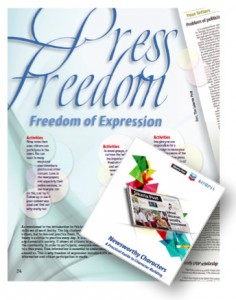 Similarly, press freedom and freedom of expression are among the 13 core virtues in “Newsworthy Characters,” a guide for using news in character education from the Jakarta Post and Kompas Daily of Indonesia. WAN-IFRA provided the press freedom/freedom of expression activities, which can be downloaded at the bottom of this page. For more information about the guide itself, which is in both Indonesian and English, contact kabar@kompas.com or info@thejakartapost.com
Similarly, press freedom and freedom of expression are among the 13 core virtues in “Newsworthy Characters,” a guide for using news in character education from the Jakarta Post and Kompas Daily of Indonesia. WAN-IFRA provided the press freedom/freedom of expression activities, which can be downloaded at the bottom of this page. For more information about the guide itself, which is in both Indonesian and English, contact kabar@kompas.com or info@thejakartapost.com
 Do a press freedom
Do a press freedom
poster project
Level of effort - easy.
Can just promote and cover.
Persuade even one teacher to have the class design posters that teach their peers or younger students about the importance and fragility of press freedom. Minimum goal would be to cover the process and print some of the best. Could also be a contest in which the community votes for the best poster. More about how to do such a project HERE.
DO A FESTIVAL : Free to Tweet
Level of effort - intermediate or higher depending on how elaborate.
Set up with your social media team, promote, monitor, cover, reward.
 Challenge youth in your area to create a slogan to tweet on 3 May World Press Freedom Day. A contest in United States first did this in 2011, attracting thousands of entries. The winner there in 2012? "Pen & paper may not be free, but the words we choose to write are." The rules for that contest, in English, are HERE.
Challenge youth in your area to create a slogan to tweet on 3 May World Press Freedom Day. A contest in United States first did this in 2011, attracting thousands of entries. The winner there in 2012? "Pen & paper may not be free, but the words we choose to write are." The rules for that contest, in English, are HERE.
DO A FESTIVAL: Free to Video
Level of effort - advanced.
Set up with your social media team, promote, monitor, cover, reward.
Challenge youth in your area to create and submit (on your site or elsewhere) short videos celebrating freedom of expression and freedom of the press. Judge the best or put them up for a vote. Here's an example (in English0 of how one organization organized such a festival: http://www.nyclu.org/contest
DO A FESTIVAL: Free to Draw
Level of effort - intermediate to advanced, depending on how much you do.
Get your cartoonist(s) involved, organize, promote.
 There are lots of ways to do this. Guardian (United Kingdom) teaches about the role of cartoons during “The Big Draw,” a day-long évent when families can attend talks and take part in a range of workshops with top cartoonists, illustrators and artists. Activities include caricature, cartoon strips, portraiture and overcoming a fear of drawing. The Buffalo Evening News (USA) offers a workshop to help the 11 to 16-year-olds who can enter its editorial cartooning contest and Jornal da Manhå of Brazil asked children to create editorial cartoons as part of a newsmaking contest about traffic safety. You can see great
There are lots of ways to do this. Guardian (United Kingdom) teaches about the role of cartoons during “The Big Draw,” a day-long évent when families can attend talks and take part in a range of workshops with top cartoonists, illustrators and artists. Activities include caricature, cartoon strips, portraiture and overcoming a fear of drawing. The Buffalo Evening News (USA) offers a workshop to help the 11 to 16-year-olds who can enter its editorial cartooning contest and Jornal da Manhå of Brazil asked children to create editorial cartoons as part of a newsmaking contest about traffic safety. You can see great examples of such work on the site of Cartooning for Peace, founded by Le Monde cartoonist Plantu, and the latest cartoons donated for WAN-IFRA to offer to newspapers everywhere at www.worldpressfreedomday.org
examples of such work on the site of Cartooning for Peace, founded by Le Monde cartoonist Plantu, and the latest cartoons donated for WAN-IFRA to offer to newspapers everywhere at www.worldpressfreedomday.org
DO A FESTIVAL: Free to Publish
Level of effort- intermediate to advanced
Organize with schools, promote, judge, cover.
Honor a student team and adviser who make the best use of the WAN-IFRA 3 May World Press Freedom Day materials in a school newspaper that effectively explain to fellow students why they should care about press freedom.
Details in English about how to do it here.
Even your printing plant can help:
the case of Sinag in the Philippines
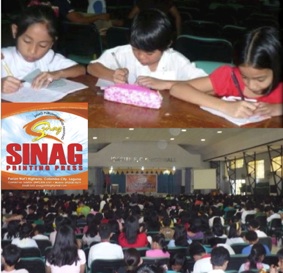 To find out exactly what they did, download PDF at the bottom of the page
To find out exactly what they did, download PDF at the bottom of the page
After more than two dozen Philippine journalists were murdered in an attack as they rode buses through Ampatuan during the 2009 presidential campaign, the Sinag printing company, publishers of two tiny weekly newspapers, decided it was time to teach about press freedom. They created a day-long program of workshops about all facets of journalism and invited anyone in the community to attend.
One thousand people showed up.
“We chose journalism seminars because as newspaper publishers/printers, Sinag is in a position to share our knowledge of newspapering to the youth of our community, explained the owners, Jennifer E. Dela Pena and Ruel T. Landicho. “We also believe that in a time when press freedom is being attacked in our country (So many journalists killed in what critics call a “culture of impunity in the Philippines”), it I simportant to teach our youth that journalism is not just a “dangerous job” as most people here perceive nowadays, but a noble profession‐‐ a vocaion and not just a career. That’s why we engaged practicing journalists as our seminar speakers ‐‐ so as to provide the perspectivve of actual journalists who have knowledge of current industry practices and issues in the Philippines.” The seminars continued for two more years, but with a limit of 300 people (The “Sinag Printing Plant workshops) PDF download at the bottom of the page gives full details about what they did.)
 The programme was awarded the first WAN-IFRA Nasasa Prize, a category of our World Young Reader Prize especially for newsppaer printing plants that teach about journalims and press freedom. It is named after Natasa Vuckovic Lesendric, who did just that with Serbia’s first printing press for and owned by non-government newspapers. The company supported the country's first newspapers in education program and invited students in on 3 May Press Freedom Day to make giant posters using excess newsprint.
The programme was awarded the first WAN-IFRA Nasasa Prize, a category of our World Young Reader Prize especially for newsppaer printing plants that teach about journalims and press freedom. It is named after Natasa Vuckovic Lesendric, who did just that with Serbia’s first printing press for and owned by non-government newspapers. The company supported the country's first newspapers in education program and invited students in on 3 May Press Freedom Day to make giant posters using excess newsprint.
When freedom is attacked
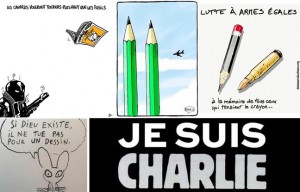
In the wake of the massacre of journalists and the police protecting them at the Charlie Hebdo newspaper headquarters in Paris, political cartoonists from around the world showed solidarity -- as did the French population through spontaneous gatherings of tens of thousands of people and the world at large through the #jesuischarlie (I am Charlie) Twitter hashtag. The Charlie Hebo staff were political cartoonists who believed that the way to mutual respect was though laughing -- without being mean -- at most everything and everyone. Seventeen people, including journalists and policemen, lost their lives in three days of violence that began with the shooting attack on the satirical newspaper Charlie Hebdo on January 6 and ended with a hostage-taking at a kosher supermarket two days later. The three gunmen were also killed.
 HERE is a link to six tips -- for editors to share -- from a leading editor of newspapers for children and teenagers about how to talk to the young about horrific news events.
HERE is a link to six tips -- for editors to share -- from a leading editor of newspapers for children and teenagers about how to talk to the young about horrific news events.
HERE is a link to bout WAN-IFRA's own background essay about the attack (by our director of press freedom, Andrew Heslop)




